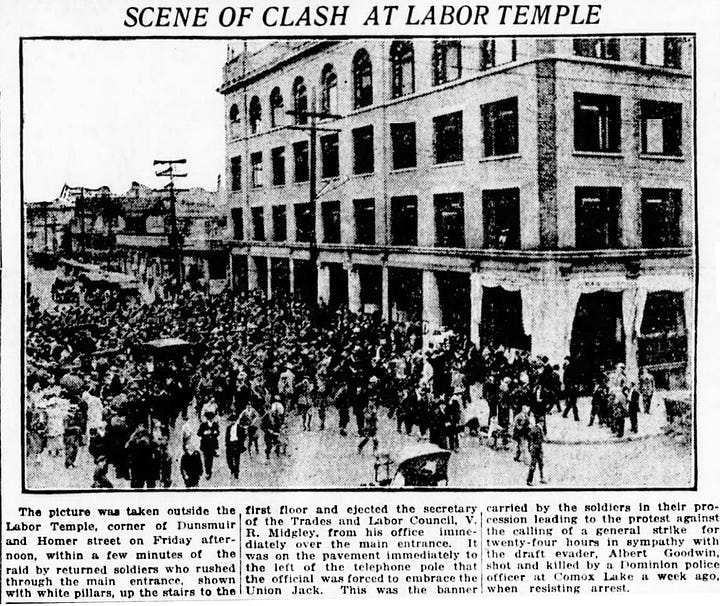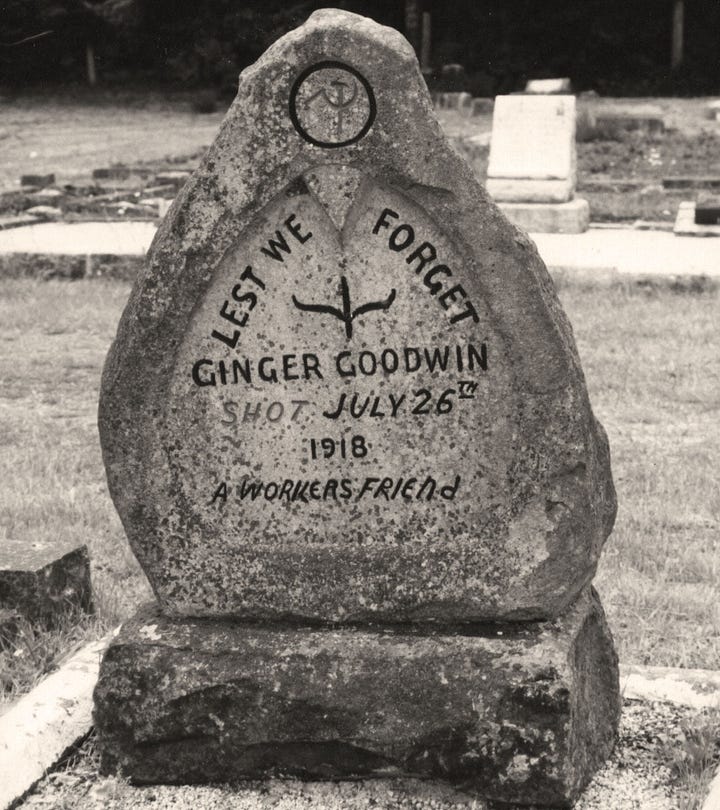"Let me tell you the story of the blacklisted miners
And that the company that owns this town.
Where to keep a man quiet, you shoot a man in the back.
That's why they shot Ginger Down."
— The Day They Shot Ginger Down, Gord Carter
The resistance tour was just on beautiful Vancouver Island. I had been invited by my dear friend Gord Johns, a fierce MP for the people of his region.
Before I went, Gord asked me if there was something special that I wanted to do during my visit to the Pacific coast.
"I would like to pay my respects at Ginger Goodwin's grave," I replied.
Gord wasn't surprised.
They don't teach the story of Ginger Goodwin in our history books. But his memory has been held sacred by generations of miners and workers. I knew it was important to conjure some of Goodwin's spirit of justice and resistance for the fight ahead.
When I arrived at the gravesite, a group of people was already there to welcome me.
Local singer Meaghan Cursons shared the haunting song The Day They Shot Ginger Down. You can watch a short video of our time at the grave here.
A Force for Justice
To understand the story of Ginger Goodwin, you need to know what life was like for working people at the turn of the last century.
The coal mines of Cumberland, in the beautiful Comox Valley of British Columbia, made a fortune for the owners — but it came at a terrible cost. The men who went down into those mines each day risked everything. Many were killed. Others returned home maimed, broken, or never the same again.
The company drove down wages by importing workers from China and Japan. The Chinese were brought over by the company that paid their passage along with the odious head tax imposed on every Chinese immigrant. Then, the men had to work for free until those costs had been paid off. They worked years to get out of debt and were often sent into the most dangerous parts of the mine.
On February 15, 1901, the No. 6 mine in Cumberland blew up, killing 26 white workers, 9 Japanese and 35 Chinese workers.
In 1902, another 16 men were killed in a gas explosion. There was an equally brutal gas explosion in the neighbouring No. 4 mine.
Over the years, more than 300 miners were killed in the Cumberland mines.
In 1906, Albert "Ginger" Goodwin, emigrated from England to work in the coal mines. He saw the injustice and began to organize the workers. Ginger became the vice president of the British Columbia Federation of Labour.
At the height of the First World War, he organized the mill and smelter workers in Trail to fight for the eight-hour day.
Goodwin was not afraid to speak the truth of the worker’s struggle. As he once wrote,
“the masters can howl: we do not hide our intentions, for we are what they have made us - the dispossessed class that is out to overthrow them.”
This made him a marked man.
As a result of his work on the strike, Goodwin was ordered to go on active duty to the war in France — even though he had already been rejected for service because he was suffering from incurable silicosis.
Goodwin refused. Instead he continued to fight to improve the working conditions for the miners in Cumberland.
On July 27, 1918, he was gunned down by a hired constable and murdered.
Ginger Goodwin was 31 years old.


If the coal bosses thought they had rid themselves of Goodwin, they were mistaken. His funeral was the largest ever held in Cumberland.
In the years that followed, people gathered every year at his grave. Even today, the Miners Memorial Weekend in Cumberland draws a huge gathering of activists, artists and workers. They all make their way to Ginger Goodwin's grave.
I come from mining country so Goodwin's story has always touched me deeply.
No company or government gave us the huge advances in health and safety, wages, and environmental protections. It was workers who fought hard for them — enduring threats, the blacklist and, yes, violence.
But they built a world that was so much better than what was before.
We stand on the shoulders of giants like Ginger Goodwin.
We live in an era when the economically powerful are working to erase the gains that previous generations fought and died for. Trump isn't the origin of this assault on our democracy and our society. He is just their chaotic avatar. Behind him are oligarchs who are every bit as brutal as those who had Goodwin murdered.
They want to make us economically insecure and frightened. To do this, they must break apart our structures of solidarity.
As Paul Mason writes in PostCapitalism:
"The destruction of labour's bargaining power … was the essence of the entire [right wing] project: it was a means to all the other ends. Neoliberalism's guiding principle is not free markets, nor fiscal discipline, nor sound money, nor privatization and offshoring—not even globalization. All these things were byproducts or weapons of its main endeavour: to remove organized labour from the equation."
Project 2025 is the logical and dark next step of 40 years of class war by the ever-powerful super-rich.
I invoke the spirit of Ginger Goodwin to remind us of our powerful history of resistance. We need to reclaim this history. Unless we know stories of those who stood up, we will be told there is no point in standing up.
This brings me to the powerful reflection by Rebecca Solnit in her book Hope in the Dark:
"The status quo would like you to believe that it is immutable, inevitable, and invulnerable, and lack of memory of a dynamically changing world reinforces this view… when you don't know how much things have changed, you don't see that they are changing or that they can change…The branches are hope; the roots are memory."
In these dark times, I see small shoots of hope breaking through. But hope needs tending. It grows when we remember those who carried the struggle before us — and act with their courage in our own time.
Memory is resistance and for the fight ahead, I will carry Goodwin’s legacy with me.
And if you ever find yourself driving Highway 19, remember, you’re travelling along Ginger Goodwin Way — carrying his story forward, kilometre by kilometre.






Terrific article. This is the kind of stuff that should be taught in schools everywhere in Canada.
Love how you bring the importance of people in. Canadian history alive. This story is very relevant today! Thank you for sharing it with your readership and followers.